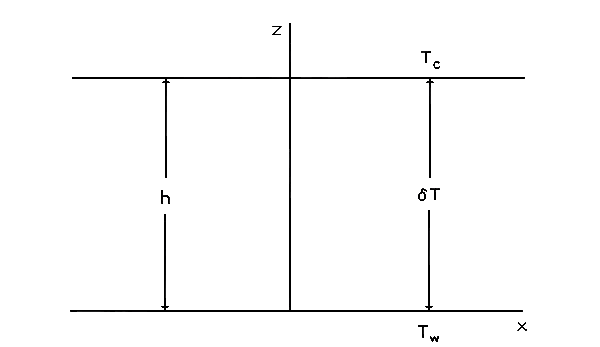|
The
Lorenz Model
Versão
em Português
C.1 Introduction
In this
appendix we show how the Lorenz model equations introduced
in Chapter 1 are developed (derived is too strong a word)
from the Navier-Stokes equation for fluid flow and the equation
describing thermal energy diffusion. This development provides
a prototype for the common process of finding approximate,
but useful, model equations when we cannot solve the fundamental
equations describing some physical situation.
The Lorenz model
has become almost totemistic in the field of nonlinear dynamics.
Unfortunately, most derivations of the Lorenz model equations
leave so much to the reader that they are essentially useless
for all but specialists in fluid dynamics. In this appendix,
we hope to give a sufficiently complete account that readers
of this text come away with a good understanding of both the
physics content and the mathematical approximations that go
into this widely cited model.
The Lorenz model
describes the motion of a fluid under conditions of Rayleigh-Bénard
flow: an incompressible fluid is contained in a cell which
has a higher temperature Tw at the bottom
and a lower temperature Tc at the top. The
temperature difference δT = Tw -
Tc is taken to be the control parameter
for the system. The geometry is shown in Fig. C.1.
Before launching
into the formal treatment of Rayleigh-Bénard flow, we should
develop some intuition about the conditions that cause convective
flow to begin. In rough terms, when the temperature gradient
between the top and bottom plates becomes sufficiently large,
a small packet of fluid that happens to move up a bit will
experience a net upward buoyant force because it has moved
into a region of lower temperature and hence higher density:
It is now less dense than its surroundings. If the upward
force is sufficient1y strong, the packet will move upward
more quickly than its temperature can drop. (Since the packet
is initially warmer than its surroundings, it will tend to
loose thermal energy to its environment.) Then convective
currents will begin to flow. On the other hand if the buoyant
force is relatively weak, the temperature of the packet will
drop before it can move a significant distance, and it remains
stable in position.
 |
Fig.
C.1. A diagram of the geometry for the Lorenz model.
The system is infinite in extent in the horizontal direction
and in the direction in and out of the page. z = 0 at
the bottom plate. |
We can be slightly
more quantitative about this behavior by using our knowledge
(gained in Chapter 11) about thermal energy diffusion and
viscous forces in fluids. Imagine that the fluid is originally
at rest. We want to see if this condition is stable. We begin
by considering a small packet of fluid that finds itself displaced
upward by a small amount ∆z. The temperature
in this new region is lower by the amount ∆T =
(δT/h )∆z. According
to the thermal energy diffusion equation (Chapter 11), the
rate of change of temperature is equal to the thermal diffusion
coefficient DT multiplied by the Laplacian
of the temperature function. For this small displacement,
we may approximate the Laplacian by
We then define
a thermal relaxation time δtT such
that
where the second
equality follows from the thermal diffusion equation. U sing
our approximation for the Laplacian, we find that
Let us now consider
the effect of the buoyant force on the packet of fluid. This
buoyant force is proportional to the difference in density
between the packet and its surroundings. This difference itself
is proportional to the thermal expansion coefficient α
(which gives the relative change in density per unit temperature
change) and the temperature difference ∆T. Thus,
we find for the buoyant force
where ρ0
is the original density of the fluid and g is the acceleration
doe to gravity.
We assume that
this buoyant force just balances the fluid viscous force;
therefore, the packet moves with a constant velocity vz.
It then takes a time τd = ∆z/vz
for the packet to be displaced through the distance ∆z.
As we learned in Chapter 11, the viscous force is equal
to the viscosity of the fluid multiplied by the Laplacian
of the velocity. Thus, we approximate the viscous force as
where the right-most
equality states our approximation for the Laplacian of vz.
If we now require
that the buoyant force be equal in magnitude to the viscous
force, we find that vz can be expressed
as
The displacement
time is then given by
The original
nonconvecting state is stable if the thermal diffusion time
is less than the corresponding displacement time. If the thermal
diffusion time is longer, then the fluid packet will continue
to feel an upward force, and convection will continue. The
important ratio is the ratio of the thermal diffusion time
to the displacement time. This ratio is called the Rayleigh
number R and takes the form
As we shall see,
the Rayleigh number is indeed the critical parameter for Rayleigh-Bénard
convection, but we need a more detailed calculation to tell
us the actual value of the Rayleigh number at which convection
begins.
|








